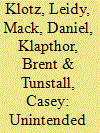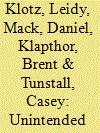|
|
|
Sort Order |
|
|
|
Items / Page
|
|
|
|
|
|
|
| Srl | Item |
| 1 |
ID:
119204


|
|
|
|
|
| Publication |
2013.
|
| Summary/Abstract |
In this paper we develop a simple model with anchoring and loss aversion to explain house price dynamics. The model has two testable implications: 1) when both cognitive biases are present, price dispersion and trade volume are pro-cyclical; 2) if anchoring decreases with time, then price dispersion and trade volume are higher for transactions with a previous purchase that is more recent. Using a data set that contains most real estate transactions in Hong Kong from 1992 to 2006, we find anchoring and loss aversion to be important, and the results are robust to type of housing and sample period. The finding is consistent with the strong correlations among house price, price dispersion, and volume found in the data. Moreover, anchoring, price dispersion and volume decrease with time since previous transaction. Our results suggest that anchoring and loss aversion contribute to the cyclicality of the housing market.
|
|
|
|
|
|
|
|
|
|
|
|
|
|
|
|
| 2 |
ID:
146624


|
|
|
|
|
| Summary/Abstract |
The anchoring effect is a well-studied subject. This article connects the effect with the rules-in-use within a military intelligence institution. Particularly the rules-in-use that dictate that an analyst takes his or hers starting point from recently conducted assessments of the specific area or threat. The threat assessment as well as the written assessment were affected. The results show that officers have an aversion to lower a previous given threat assessment. This gives that to understand risk assessment we not only need to understand the methods used, we also need to understand the institutions in which they are used. This is especially relevant for military intelligence as the assessments are conducted in an environment of high uncertainty.
|
|
|
|
|
|
|
|
|
|
|
|
|
|
|
|
| 3 |
ID:
096722


|
|
|
|
|
| Publication |
2010.
|
| Summary/Abstract |
In the U.S., where buildings account for 40% of energy use, commercial buildings use more energy per unit area than ever before. However, exemplary buildings demonstrate the feasibility of much better energy performance at no additional first cost. This research examines one possible explanation for this inconsistency. The aim is to investigate whether the anchoring bias, which refers to our tendency to gravitate towards a pre-defined standard regardless of its relevance, influences energy performance goals in building design. The scope examines professionals who help set energy performance goals for U.S. buildings. Prior to being asked to set an energy performance goal, these professionals were randomly directed to one of three series of questions. One series set an anchor of 90% energy reduction beyond standard practice, one set a 30% anchor, and one set no anchor. Respondents exposed to the 90% anchor, and respondents exposed to no anchor at all, set higher energy performance goals than respondents exposed to the 30% anchor. These results suggest that building rating systems that only reward incremental energy improvements may inadvertently create anchors, thereby discouraging more advanced energy performance goals and inhibiting energy performance that is technically and economically feasible.
|
|
|
|
|
|
|
|
|
|
|
|
|
|
|
|
| 4 |
ID:
097515


|
|
|
|
|
| Publication |
2010.
|
| Summary/Abstract |
In the U.S., where buildings account for 40% of energy use, commercial buildings use more energy per unit area than ever before. However, exemplary buildings demonstrate the feasibility of much better energy performance at no additional first cost. This research examines one possible explanation for this inconsistency. The aim is to investigate whether the anchoring bias, which refers to our tendency to gravitate towards a pre-defined standard regardless of its relevance, influences energy performance goals in building design. The scope examines professionals who help set energy performance goals for U.S. buildings. Prior to being asked to set an energy performance goal, these professionals were randomly directed to one of three series of questions. One series set an anchor of 90% energy reduction beyond standard practice, one set a 30% anchor, and one set no anchor. Respondents exposed to the 90% anchor, and respondents exposed to no anchor at all, set higher energy performance goals than respondents exposed to the 30% anchor. These results suggest that building rating systems that only reward incremental energy improvements may inadvertently create anchors, thereby discouraging more advanced energy performance goals and inhibiting energy performance that is technically and economically feasible.
|
|
|
|
|
|
|
|
|
|
|
|
|
|
|
|
|
|
|
|
|